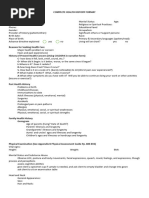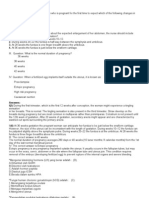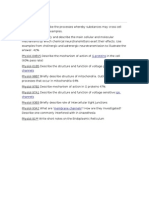Useful Formulas in Fluid Therapy
Uploaded by
Prabhakar KumarUseful Formulas in Fluid Therapy
Uploaded by
Prabhakar KumarUseful formulas in fluid therapy
Fluid volumes:
Correction of dehydration
% dehydration (estimate) x Body weight (kg)
Maintenance
Adults: 60 ml/kg/day
Neonates: 70 ml/kg/day
Total amount of fluid to give:
maintenance + replacement (% dehydration) + ongoing losses
Total bicarbonate deficit:
Base deficit x 0.3 x bodyweight (kg)= deficit in meq. To obtain deficit in grams, divide meq/12.
Commercial solutions are hypertonic: 5% and 8.4% NaHCO
3
. Isotonic bicarbonate is 1.3%.
To make isotonic bicarbonate:
Add 13 g NaHCO3, 260 ml of 5% or 154 ml of 8.4% to each liter of sterile water.
Correction of metabolic acidosis
If blood pH <7.2
Give _ of calculated deficit in 30 minutes, then rest over 12 hours
Correction of potassium deficit
Body weight (kg) x 0.4 x deficit
Potassium is an intracellular ion. Calculation of deficit based on serum concentration
provides only an estimate for fluid supplementation.
Maximum rate of administration: !0.5 meQ/L
Hypertonic saline: 4 ml/kg given during 5-10 minute period.
Calculation of osmotic pressure:
2[Na] (meq/L) + glucose/18 (mg/dl) + BUN/2.8 (mg/dl) = plasma osmotic pressure.
Anion gap
(Na
+
+K
+
) (Cl
-
+HCO
3
-
)=anion gap.
Calculating infusion rate
Drops per minute = total infusion volume (ml) x drops/ml
infusion time (min)
Total body water: 60% body weight
ECF fluid: 30 % BW
Blood volume: 8% BW
Interstitium: 22% BW
Intracellular fluid: 30% BW
Equivalent values of some salts used in fluid therapy
1g NaCl= 17 meq Na, Cl
1g NaHCO
3
= 12 meq Na, HCO
3
1g KCl = 14 meq K, Cl
1g CaCl
2
= 20 meq Ca
1g Ca gluconate = 4.5 meq Ca
1g Ca borogluconate = 4.1 meq Ca
1g MgSO
4
= 8.3 meq Mg
1 meq Na = 59 mg NaCl
1 meq Na = 84 mg NaHCO
3
1 meq Na = 112 Na Lactate
1 meq K = 74.5 mg KCl
1 meq Ca = 55 mg CaCl
2
1 meq Ca=224 mg Ca gluconate
1 meq Mg = 120 mg MgSO
4
Sodium : 23
Potassium: 39
Chloride: 35.5
Calcium: 40
Bicarbonate (HCO
3
): 61
Sodium bicarbonate: 84
You might also like
- Reading HW 5 - Match Headings, Information and Sentence EndingsNo ratings yetReading HW 5 - Match Headings, Information and Sentence Endings23 pages
- Management of The Sick Child 2 Months Up To 5 YearsNo ratings yetManagement of The Sick Child 2 Months Up To 5 Years1 page
- A Simple Guide to Hypovolemia, Diagnosis, Treatment and Related ConditionsFrom EverandA Simple Guide to Hypovolemia, Diagnosis, Treatment and Related ConditionsNo ratings yet
- Endocrine & Metabolic Response To Injury: Mete Duren, MDNo ratings yetEndocrine & Metabolic Response To Injury: Mete Duren, MD29 pages
- Describe The Factors Affecting Cardiac OutputNo ratings yetDescribe The Factors Affecting Cardiac Output6 pages
- Preanaesthetic Medication Anaesthetic AgentsNo ratings yetPreanaesthetic Medication Anaesthetic Agents35 pages
- Perm Issive Hypercapnia: Alex Rogovik,, Ran GoldmanNo ratings yetPerm Issive Hypercapnia: Alex Rogovik,, Ran Goldman12 pages
- Viva in Anaesthesiology: Questions and Answers On Abg, Drugs, Ecg, X-Ray&Others100% (2)Viva in Anaesthesiology: Questions and Answers On Abg, Drugs, Ecg, X-Ray&Others121 pages
- Symptoms and Signs of Respiratory DiseasesNo ratings yetSymptoms and Signs of Respiratory Diseases35 pages
- Local Anaesthetic Drugs 3 Power Point Presentation100% (1)Local Anaesthetic Drugs 3 Power Point Presentation30 pages
- Fluid Therapy: Presenter: Chew Zi Qi Supervisor: Dr. Tan KWNo ratings yetFluid Therapy: Presenter: Chew Zi Qi Supervisor: Dr. Tan KW43 pages
- Evaluation and Management of Elevated Intracranial Pressure in AdultsNo ratings yetEvaluation and Management of Elevated Intracranial Pressure in Adults28 pages
- Ati - Comprehensive Physical Assessment of An Adult - Comprehensive Physical Assessment of An Adult - Checklist - ChecklistNo ratings yetAti - Comprehensive Physical Assessment of An Adult - Comprehensive Physical Assessment of An Adult - Checklist - Checklist16 pages
- Moderator: Dr. R. K. Yadav (MD) Presented By: Ashish JaisawalNo ratings yetModerator: Dr. R. K. Yadav (MD) Presented By: Ashish Jaisawal47 pages
- Guidelines For Management of Diabetes MellitusNo ratings yetGuidelines For Management of Diabetes Mellitus1 page
- Cusa (Cavitron Ultrasonic Surgical Aspirator) "The New Armour of Periodontal Therapy"No ratings yetCusa (Cavitron Ultrasonic Surgical Aspirator) "The New Armour of Periodontal Therapy"4 pages
- Hypertension: Hozan Jaza MSC Clinical Pharmacy College of Pharmacy 10/12/2020No ratings yetHypertension: Hozan Jaza MSC Clinical Pharmacy College of Pharmacy 10/12/202081 pages
- Critical Care - Anesthesiology, Blood Gases, and Respiratory CareNo ratings yetCritical Care - Anesthesiology, Blood Gases, and Respiratory Care26 pages
- The Anatomical Foundations of Regional Anesthesia and Acute Pain MedicineFrom EverandThe Anatomical Foundations of Regional Anesthesia and Acute Pain MedicineNo ratings yet
- Paroxysmal Nocturnal Hemoglobinuria, A Simple Guide To The Condition, Diagnosis, Treatment And Related ConditionsFrom EverandParoxysmal Nocturnal Hemoglobinuria, A Simple Guide To The Condition, Diagnosis, Treatment And Related ConditionsNo ratings yet
- Quality of Life, and Survival in Patients With Effect of Neurolytic Celiac Plexus Block On Pain ReliefNo ratings yetQuality of Life, and Survival in Patients With Effect of Neurolytic Celiac Plexus Block On Pain Relief9 pages
- Preparation and Quality Evaluation of Flour and Biscuit From Sweet PotatoNo ratings yetPreparation and Quality Evaluation of Flour and Biscuit From Sweet Potato6 pages
- Guide To Navigating Through Crisish by Crisis KrechNo ratings yetGuide To Navigating Through Crisish by Crisis Krech12 pages
- Comprehensive Nursing Process Format Science PDFNo ratings yetComprehensive Nursing Process Format Science PDF3 pages
- Chapter 2 - P2 P3 M1 M2 Complementary TherapiesNo ratings yetChapter 2 - P2 P3 M1 M2 Complementary Therapies2 pages
- SDS WD-40 Specialist Automotive Chain Lube-AsiaNo ratings yetSDS WD-40 Specialist Automotive Chain Lube-Asia5 pages
- Calawis Method of Statement (Submersible Mixer)No ratings yetCalawis Method of Statement (Submersible Mixer)2 pages
- Jurnal Media Keperawatan: Politeknik Kesehatan Makassar Vol. . No 20 . E-Issn: 2087-0035No ratings yetJurnal Media Keperawatan: Politeknik Kesehatan Makassar Vol. . No 20 . E-Issn: 2087-00359 pages
- DIfference Nutrient Agar and Nutrient BrothNo ratings yetDIfference Nutrient Agar and Nutrient Broth1 page
- Safe and Precise Infusion: Family of Volumetric Infusion Pumps100% (1)Safe and Precise Infusion: Family of Volumetric Infusion Pumps2 pages
- Computed Tomography For Technologists A Comprehensive Text 2nd Edition Ebook PDF100% (55)Computed Tomography For Technologists A Comprehensive Text 2nd Edition Ebook PDF62 pages
- Alphabet Series Forward Backward Questions Specially For Sbi Po PrelimsNo ratings yetAlphabet Series Forward Backward Questions Specially For Sbi Po Prelims16 pages






























































































